SCS110 Major Essay: Analyzing Inequality in Australia
VerifiedAdded on 2022/11/09
|9
|2618
|2
Essay
AI Summary
This essay provides a comprehensive analysis of social inequality in Australia, examining its historical context and contemporary manifestations. It delves into various dimensions of inequality, including income disparities, gender imbalances, educational disparities, and the impact of racism. The essay traces the evolution of Australian society over the past 120 years, highlighting key events and policies that have shaped the nation's social structure. It explores the theoretical underpinnings of inequality, drawing on sociological concepts and research. The analysis considers the perspectives of immigrants and the historical context of the White Australia Policy. The essay also assesses the economic and social consequences of inequality, including its effects on labor productivity, economic stability, and education. The conclusion emphasizes the role of government in addressing inequality and promoting a more equitable society, highlighting the importance of multiculturalism and the 'fair go' culture. The essay utilizes a variety of sources, including academic journals and statistical data, to support its arguments and provide a nuanced understanding of the complexities of social inequality in Australia.
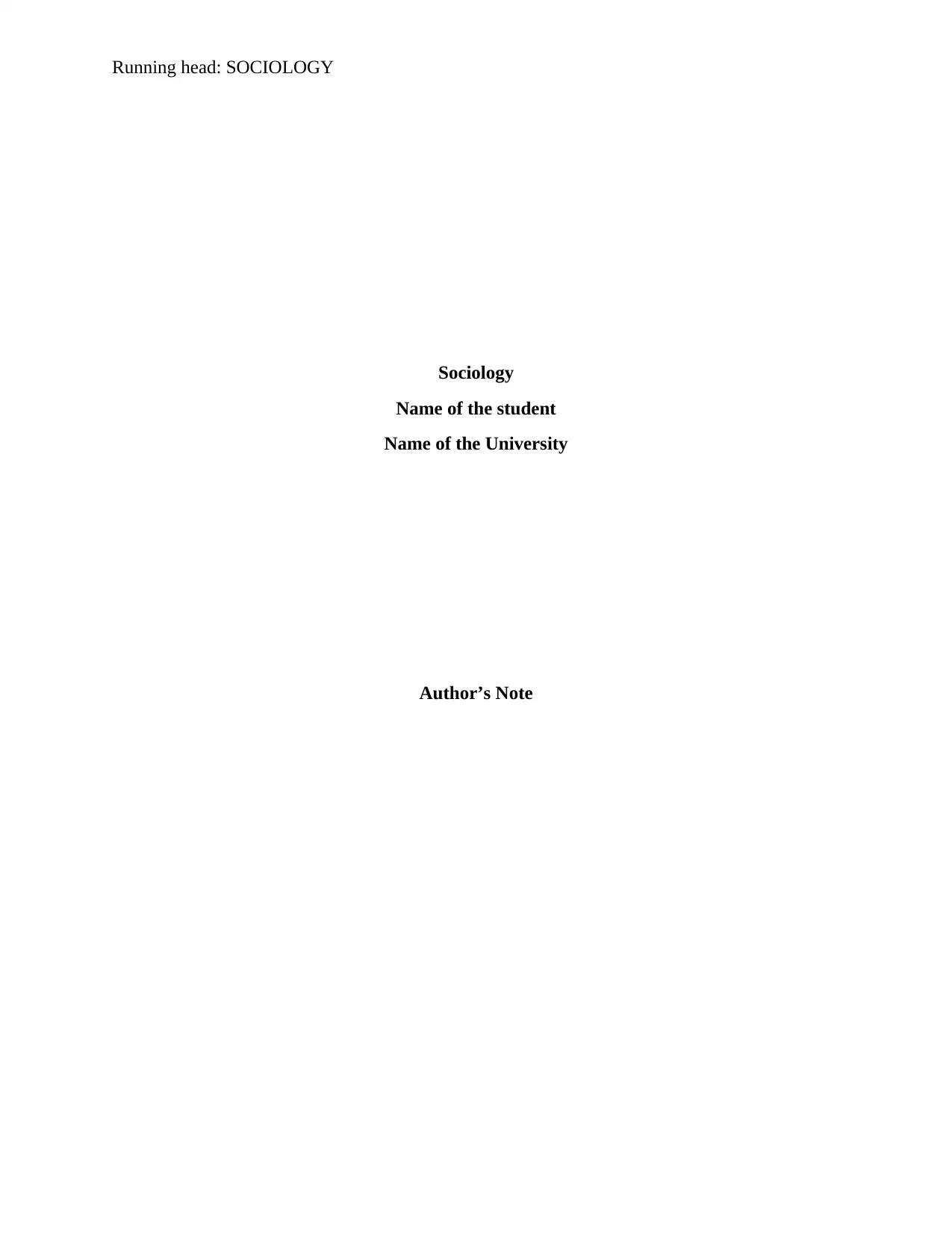
Running head: SOCIOLOGY
Sociology
Name of the student
Name of the University
Author’s Note
Sociology
Name of the student
Name of the University
Author’s Note
Paraphrase This Document
Need a fresh take? Get an instant paraphrase of this document with our AI Paraphraser
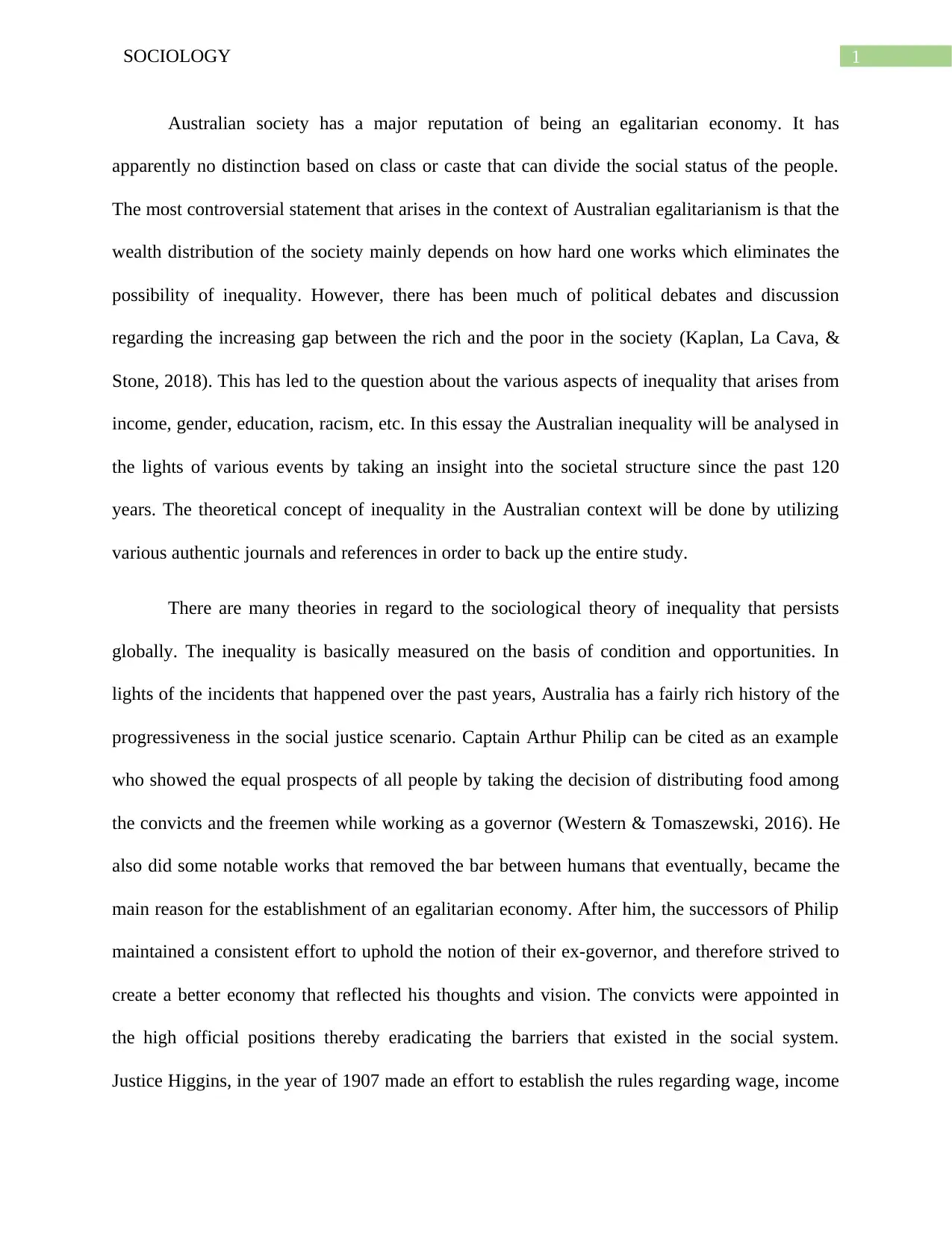
1SOCIOLOGY
Australian society has a major reputation of being an egalitarian economy. It has
apparently no distinction based on class or caste that can divide the social status of the people.
The most controversial statement that arises in the context of Australian egalitarianism is that the
wealth distribution of the society mainly depends on how hard one works which eliminates the
possibility of inequality. However, there has been much of political debates and discussion
regarding the increasing gap between the rich and the poor in the society (Kaplan, La Cava, &
Stone, 2018). This has led to the question about the various aspects of inequality that arises from
income, gender, education, racism, etc. In this essay the Australian inequality will be analysed in
the lights of various events by taking an insight into the societal structure since the past 120
years. The theoretical concept of inequality in the Australian context will be done by utilizing
various authentic journals and references in order to back up the entire study.
There are many theories in regard to the sociological theory of inequality that persists
globally. The inequality is basically measured on the basis of condition and opportunities. In
lights of the incidents that happened over the past years, Australia has a fairly rich history of the
progressiveness in the social justice scenario. Captain Arthur Philip can be cited as an example
who showed the equal prospects of all people by taking the decision of distributing food among
the convicts and the freemen while working as a governor (Western & Tomaszewski, 2016). He
also did some notable works that removed the bar between humans that eventually, became the
main reason for the establishment of an egalitarian economy. After him, the successors of Philip
maintained a consistent effort to uphold the notion of their ex-governor, and therefore strived to
create a better economy that reflected his thoughts and vision. The convicts were appointed in
the high official positions thereby eradicating the barriers that existed in the social system.
Justice Higgins, in the year of 1907 made an effort to establish the rules regarding wage, income
Australian society has a major reputation of being an egalitarian economy. It has
apparently no distinction based on class or caste that can divide the social status of the people.
The most controversial statement that arises in the context of Australian egalitarianism is that the
wealth distribution of the society mainly depends on how hard one works which eliminates the
possibility of inequality. However, there has been much of political debates and discussion
regarding the increasing gap between the rich and the poor in the society (Kaplan, La Cava, &
Stone, 2018). This has led to the question about the various aspects of inequality that arises from
income, gender, education, racism, etc. In this essay the Australian inequality will be analysed in
the lights of various events by taking an insight into the societal structure since the past 120
years. The theoretical concept of inequality in the Australian context will be done by utilizing
various authentic journals and references in order to back up the entire study.
There are many theories in regard to the sociological theory of inequality that persists
globally. The inequality is basically measured on the basis of condition and opportunities. In
lights of the incidents that happened over the past years, Australia has a fairly rich history of the
progressiveness in the social justice scenario. Captain Arthur Philip can be cited as an example
who showed the equal prospects of all people by taking the decision of distributing food among
the convicts and the freemen while working as a governor (Western & Tomaszewski, 2016). He
also did some notable works that removed the bar between humans that eventually, became the
main reason for the establishment of an egalitarian economy. After him, the successors of Philip
maintained a consistent effort to uphold the notion of their ex-governor, and therefore strived to
create a better economy that reflected his thoughts and vision. The convicts were appointed in
the high official positions thereby eradicating the barriers that existed in the social system.
Justice Higgins, in the year of 1907 made an effort to establish the rules regarding wage, income
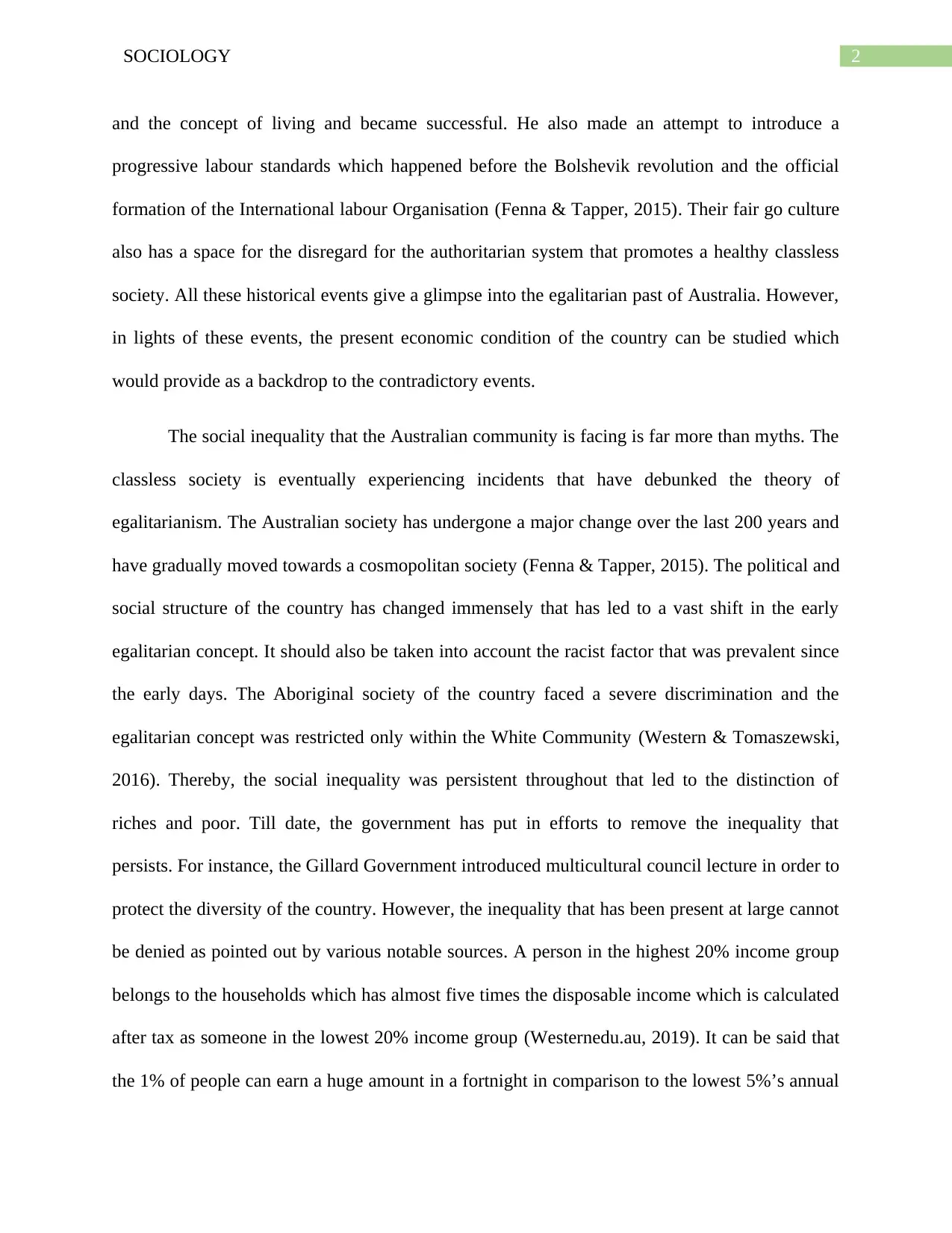
2SOCIOLOGY
and the concept of living and became successful. He also made an attempt to introduce a
progressive labour standards which happened before the Bolshevik revolution and the official
formation of the International labour Organisation (Fenna & Tapper, 2015). Their fair go culture
also has a space for the disregard for the authoritarian system that promotes a healthy classless
society. All these historical events give a glimpse into the egalitarian past of Australia. However,
in lights of these events, the present economic condition of the country can be studied which
would provide as a backdrop to the contradictory events.
The social inequality that the Australian community is facing is far more than myths. The
classless society is eventually experiencing incidents that have debunked the theory of
egalitarianism. The Australian society has undergone a major change over the last 200 years and
have gradually moved towards a cosmopolitan society (Fenna & Tapper, 2015). The political and
social structure of the country has changed immensely that has led to a vast shift in the early
egalitarian concept. It should also be taken into account the racist factor that was prevalent since
the early days. The Aboriginal society of the country faced a severe discrimination and the
egalitarian concept was restricted only within the White Community (Western & Tomaszewski,
2016). Thereby, the social inequality was persistent throughout that led to the distinction of
riches and poor. Till date, the government has put in efforts to remove the inequality that
persists. For instance, the Gillard Government introduced multicultural council lecture in order to
protect the diversity of the country. However, the inequality that has been present at large cannot
be denied as pointed out by various notable sources. A person in the highest 20% income group
belongs to the households which has almost five times the disposable income which is calculated
after tax as someone in the lowest 20% income group (Westernedu.au, 2019). It can be said that
the 1% of people can earn a huge amount in a fortnight in comparison to the lowest 5%’s annual
and the concept of living and became successful. He also made an attempt to introduce a
progressive labour standards which happened before the Bolshevik revolution and the official
formation of the International labour Organisation (Fenna & Tapper, 2015). Their fair go culture
also has a space for the disregard for the authoritarian system that promotes a healthy classless
society. All these historical events give a glimpse into the egalitarian past of Australia. However,
in lights of these events, the present economic condition of the country can be studied which
would provide as a backdrop to the contradictory events.
The social inequality that the Australian community is facing is far more than myths. The
classless society is eventually experiencing incidents that have debunked the theory of
egalitarianism. The Australian society has undergone a major change over the last 200 years and
have gradually moved towards a cosmopolitan society (Fenna & Tapper, 2015). The political and
social structure of the country has changed immensely that has led to a vast shift in the early
egalitarian concept. It should also be taken into account the racist factor that was prevalent since
the early days. The Aboriginal society of the country faced a severe discrimination and the
egalitarian concept was restricted only within the White Community (Western & Tomaszewski,
2016). Thereby, the social inequality was persistent throughout that led to the distinction of
riches and poor. Till date, the government has put in efforts to remove the inequality that
persists. For instance, the Gillard Government introduced multicultural council lecture in order to
protect the diversity of the country. However, the inequality that has been present at large cannot
be denied as pointed out by various notable sources. A person in the highest 20% income group
belongs to the households which has almost five times the disposable income which is calculated
after tax as someone in the lowest 20% income group (Westernedu.au, 2019). It can be said that
the 1% of people can earn a huge amount in a fortnight in comparison to the lowest 5%’s annual
⊘ This is a preview!⊘
Do you want full access?
Subscribe today to unlock all pages.

Trusted by 1+ million students worldwide
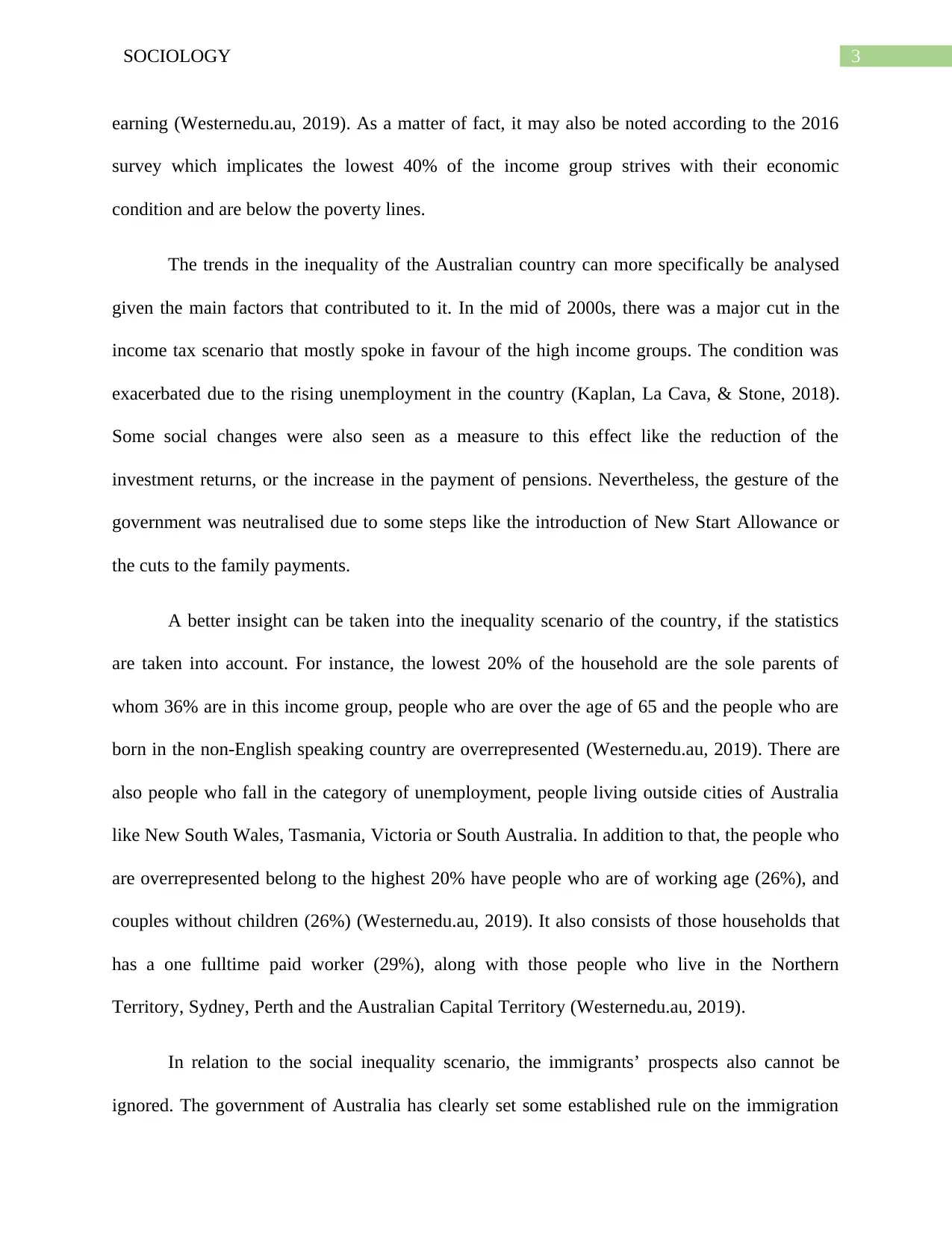
3SOCIOLOGY
earning (Westernedu.au, 2019). As a matter of fact, it may also be noted according to the 2016
survey which implicates the lowest 40% of the income group strives with their economic
condition and are below the poverty lines.
The trends in the inequality of the Australian country can more specifically be analysed
given the main factors that contributed to it. In the mid of 2000s, there was a major cut in the
income tax scenario that mostly spoke in favour of the high income groups. The condition was
exacerbated due to the rising unemployment in the country (Kaplan, La Cava, & Stone, 2018).
Some social changes were also seen as a measure to this effect like the reduction of the
investment returns, or the increase in the payment of pensions. Nevertheless, the gesture of the
government was neutralised due to some steps like the introduction of New Start Allowance or
the cuts to the family payments.
A better insight can be taken into the inequality scenario of the country, if the statistics
are taken into account. For instance, the lowest 20% of the household are the sole parents of
whom 36% are in this income group, people who are over the age of 65 and the people who are
born in the non-English speaking country are overrepresented (Westernedu.au, 2019). There are
also people who fall in the category of unemployment, people living outside cities of Australia
like New South Wales, Tasmania, Victoria or South Australia. In addition to that, the people who
are overrepresented belong to the highest 20% have people who are of working age (26%), and
couples without children (26%) (Westernedu.au, 2019). It also consists of those households that
has a one fulltime paid worker (29%), along with those people who live in the Northern
Territory, Sydney, Perth and the Australian Capital Territory (Westernedu.au, 2019).
In relation to the social inequality scenario, the immigrants’ prospects also cannot be
ignored. The government of Australia has clearly set some established rule on the immigration
earning (Westernedu.au, 2019). As a matter of fact, it may also be noted according to the 2016
survey which implicates the lowest 40% of the income group strives with their economic
condition and are below the poverty lines.
The trends in the inequality of the Australian country can more specifically be analysed
given the main factors that contributed to it. In the mid of 2000s, there was a major cut in the
income tax scenario that mostly spoke in favour of the high income groups. The condition was
exacerbated due to the rising unemployment in the country (Kaplan, La Cava, & Stone, 2018).
Some social changes were also seen as a measure to this effect like the reduction of the
investment returns, or the increase in the payment of pensions. Nevertheless, the gesture of the
government was neutralised due to some steps like the introduction of New Start Allowance or
the cuts to the family payments.
A better insight can be taken into the inequality scenario of the country, if the statistics
are taken into account. For instance, the lowest 20% of the household are the sole parents of
whom 36% are in this income group, people who are over the age of 65 and the people who are
born in the non-English speaking country are overrepresented (Westernedu.au, 2019). There are
also people who fall in the category of unemployment, people living outside cities of Australia
like New South Wales, Tasmania, Victoria or South Australia. In addition to that, the people who
are overrepresented belong to the highest 20% have people who are of working age (26%), and
couples without children (26%) (Westernedu.au, 2019). It also consists of those households that
has a one fulltime paid worker (29%), along with those people who live in the Northern
Territory, Sydney, Perth and the Australian Capital Territory (Westernedu.au, 2019).
In relation to the social inequality scenario, the immigrants’ prospects also cannot be
ignored. The government of Australia has clearly set some established rule on the immigration
Paraphrase This Document
Need a fresh take? Get an instant paraphrase of this document with our AI Paraphraser
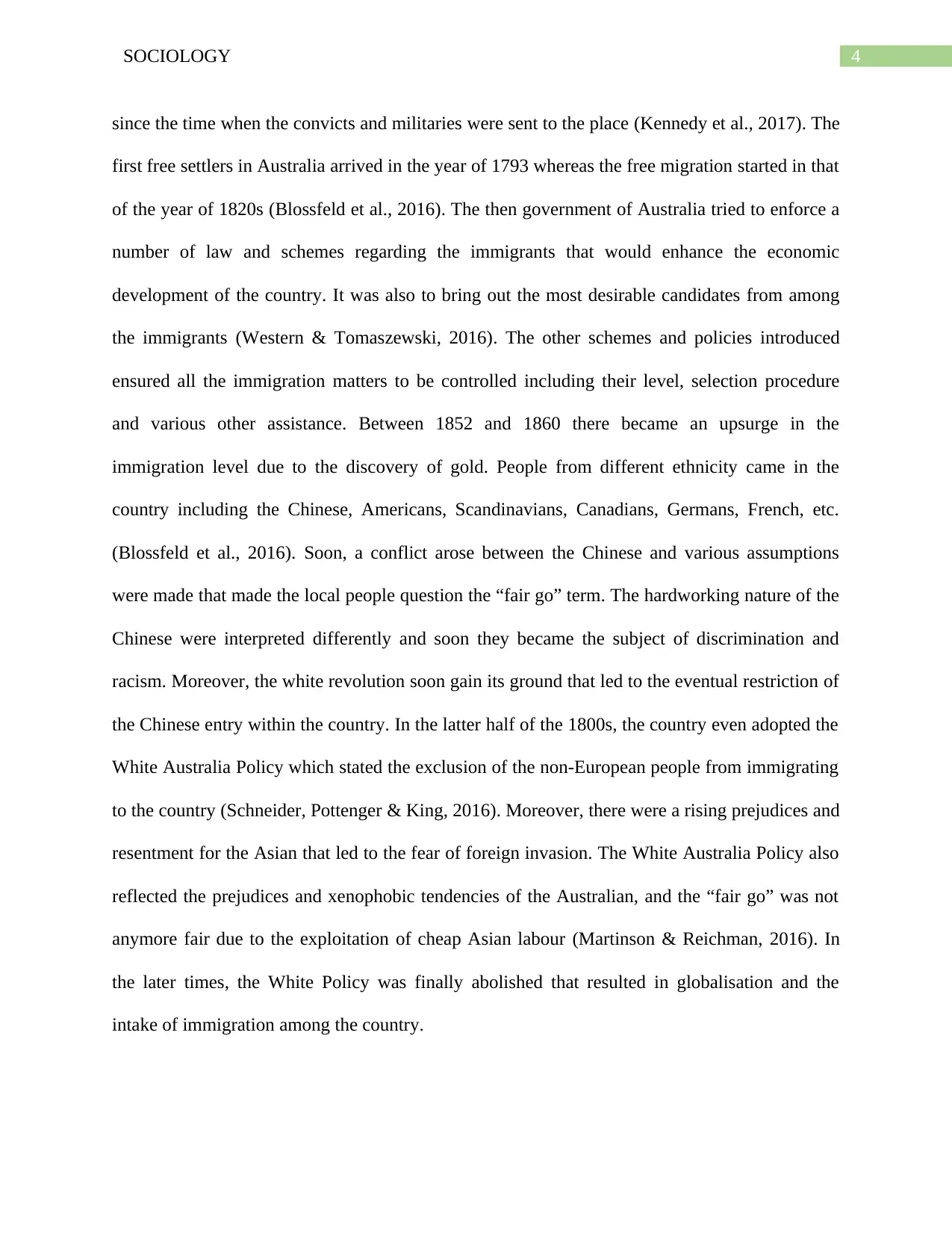
4SOCIOLOGY
since the time when the convicts and militaries were sent to the place (Kennedy et al., 2017). The
first free settlers in Australia arrived in the year of 1793 whereas the free migration started in that
of the year of 1820s (Blossfeld et al., 2016). The then government of Australia tried to enforce a
number of law and schemes regarding the immigrants that would enhance the economic
development of the country. It was also to bring out the most desirable candidates from among
the immigrants (Western & Tomaszewski, 2016). The other schemes and policies introduced
ensured all the immigration matters to be controlled including their level, selection procedure
and various other assistance. Between 1852 and 1860 there became an upsurge in the
immigration level due to the discovery of gold. People from different ethnicity came in the
country including the Chinese, Americans, Scandinavians, Canadians, Germans, French, etc.
(Blossfeld et al., 2016). Soon, a conflict arose between the Chinese and various assumptions
were made that made the local people question the “fair go” term. The hardworking nature of the
Chinese were interpreted differently and soon they became the subject of discrimination and
racism. Moreover, the white revolution soon gain its ground that led to the eventual restriction of
the Chinese entry within the country. In the latter half of the 1800s, the country even adopted the
White Australia Policy which stated the exclusion of the non-European people from immigrating
to the country (Schneider, Pottenger & King, 2016). Moreover, there were a rising prejudices and
resentment for the Asian that led to the fear of foreign invasion. The White Australia Policy also
reflected the prejudices and xenophobic tendencies of the Australian, and the “fair go” was not
anymore fair due to the exploitation of cheap Asian labour (Martinson & Reichman, 2016). In
the later times, the White Policy was finally abolished that resulted in globalisation and the
intake of immigration among the country.
since the time when the convicts and militaries were sent to the place (Kennedy et al., 2017). The
first free settlers in Australia arrived in the year of 1793 whereas the free migration started in that
of the year of 1820s (Blossfeld et al., 2016). The then government of Australia tried to enforce a
number of law and schemes regarding the immigrants that would enhance the economic
development of the country. It was also to bring out the most desirable candidates from among
the immigrants (Western & Tomaszewski, 2016). The other schemes and policies introduced
ensured all the immigration matters to be controlled including their level, selection procedure
and various other assistance. Between 1852 and 1860 there became an upsurge in the
immigration level due to the discovery of gold. People from different ethnicity came in the
country including the Chinese, Americans, Scandinavians, Canadians, Germans, French, etc.
(Blossfeld et al., 2016). Soon, a conflict arose between the Chinese and various assumptions
were made that made the local people question the “fair go” term. The hardworking nature of the
Chinese were interpreted differently and soon they became the subject of discrimination and
racism. Moreover, the white revolution soon gain its ground that led to the eventual restriction of
the Chinese entry within the country. In the latter half of the 1800s, the country even adopted the
White Australia Policy which stated the exclusion of the non-European people from immigrating
to the country (Schneider, Pottenger & King, 2016). Moreover, there were a rising prejudices and
resentment for the Asian that led to the fear of foreign invasion. The White Australia Policy also
reflected the prejudices and xenophobic tendencies of the Australian, and the “fair go” was not
anymore fair due to the exploitation of cheap Asian labour (Martinson & Reichman, 2016). In
the later times, the White Policy was finally abolished that resulted in globalisation and the
intake of immigration among the country.
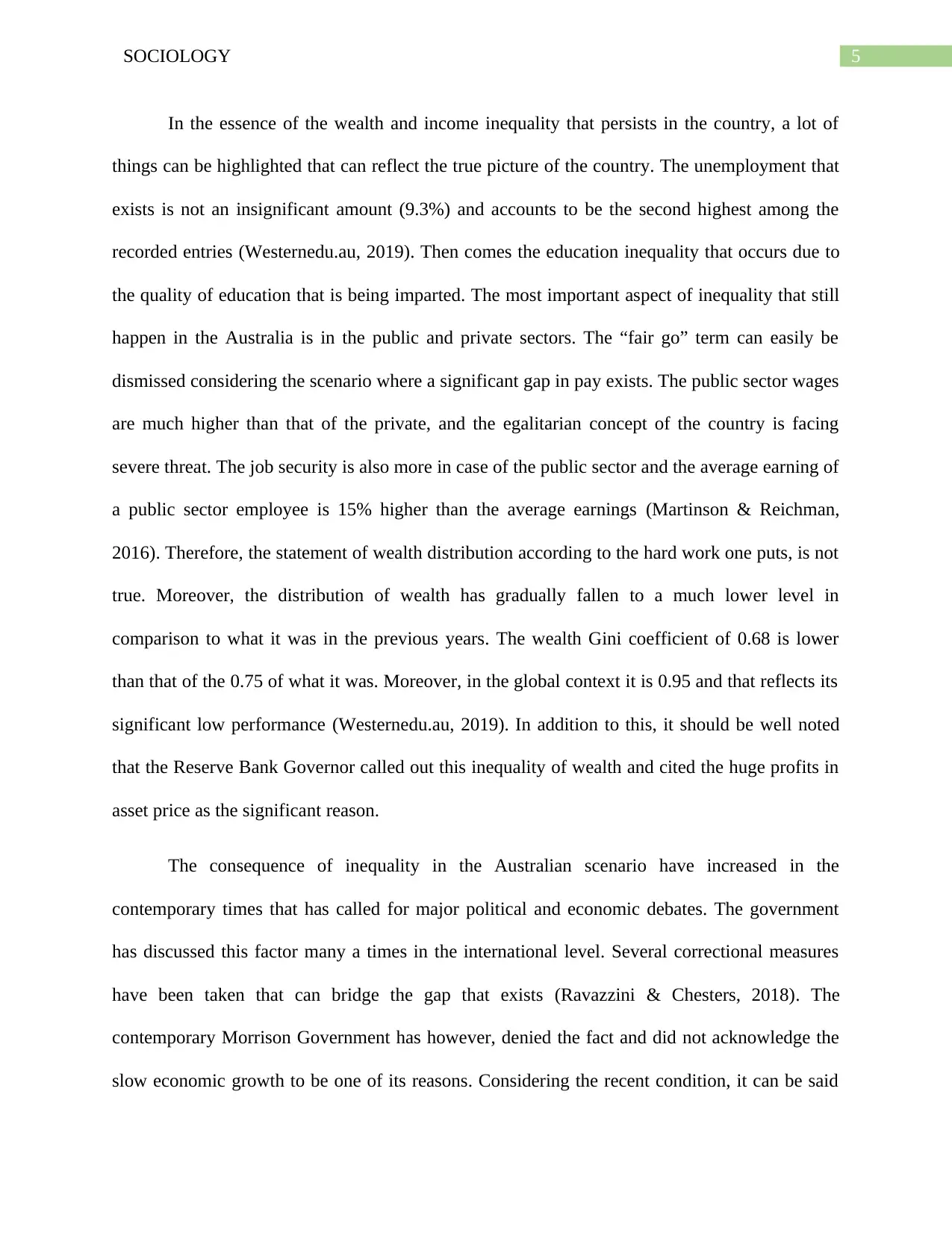
5SOCIOLOGY
In the essence of the wealth and income inequality that persists in the country, a lot of
things can be highlighted that can reflect the true picture of the country. The unemployment that
exists is not an insignificant amount (9.3%) and accounts to be the second highest among the
recorded entries (Westernedu.au, 2019). Then comes the education inequality that occurs due to
the quality of education that is being imparted. The most important aspect of inequality that still
happen in the Australia is in the public and private sectors. The “fair go” term can easily be
dismissed considering the scenario where a significant gap in pay exists. The public sector wages
are much higher than that of the private, and the egalitarian concept of the country is facing
severe threat. The job security is also more in case of the public sector and the average earning of
a public sector employee is 15% higher than the average earnings (Martinson & Reichman,
2016). Therefore, the statement of wealth distribution according to the hard work one puts, is not
true. Moreover, the distribution of wealth has gradually fallen to a much lower level in
comparison to what it was in the previous years. The wealth Gini coefficient of 0.68 is lower
than that of the 0.75 of what it was. Moreover, in the global context it is 0.95 and that reflects its
significant low performance (Westernedu.au, 2019). In addition to this, it should be well noted
that the Reserve Bank Governor called out this inequality of wealth and cited the huge profits in
asset price as the significant reason.
The consequence of inequality in the Australian scenario have increased in the
contemporary times that has called for major political and economic debates. The government
has discussed this factor many a times in the international level. Several correctional measures
have been taken that can bridge the gap that exists (Ravazzini & Chesters, 2018). The
contemporary Morrison Government has however, denied the fact and did not acknowledge the
slow economic growth to be one of its reasons. Considering the recent condition, it can be said
In the essence of the wealth and income inequality that persists in the country, a lot of
things can be highlighted that can reflect the true picture of the country. The unemployment that
exists is not an insignificant amount (9.3%) and accounts to be the second highest among the
recorded entries (Westernedu.au, 2019). Then comes the education inequality that occurs due to
the quality of education that is being imparted. The most important aspect of inequality that still
happen in the Australia is in the public and private sectors. The “fair go” term can easily be
dismissed considering the scenario where a significant gap in pay exists. The public sector wages
are much higher than that of the private, and the egalitarian concept of the country is facing
severe threat. The job security is also more in case of the public sector and the average earning of
a public sector employee is 15% higher than the average earnings (Martinson & Reichman,
2016). Therefore, the statement of wealth distribution according to the hard work one puts, is not
true. Moreover, the distribution of wealth has gradually fallen to a much lower level in
comparison to what it was in the previous years. The wealth Gini coefficient of 0.68 is lower
than that of the 0.75 of what it was. Moreover, in the global context it is 0.95 and that reflects its
significant low performance (Westernedu.au, 2019). In addition to this, it should be well noted
that the Reserve Bank Governor called out this inequality of wealth and cited the huge profits in
asset price as the significant reason.
The consequence of inequality in the Australian scenario have increased in the
contemporary times that has called for major political and economic debates. The government
has discussed this factor many a times in the international level. Several correctional measures
have been taken that can bridge the gap that exists (Ravazzini & Chesters, 2018). The
contemporary Morrison Government has however, denied the fact and did not acknowledge the
slow economic growth to be one of its reasons. Considering the recent condition, it can be said
⊘ This is a preview!⊘
Do you want full access?
Subscribe today to unlock all pages.

Trusted by 1+ million students worldwide
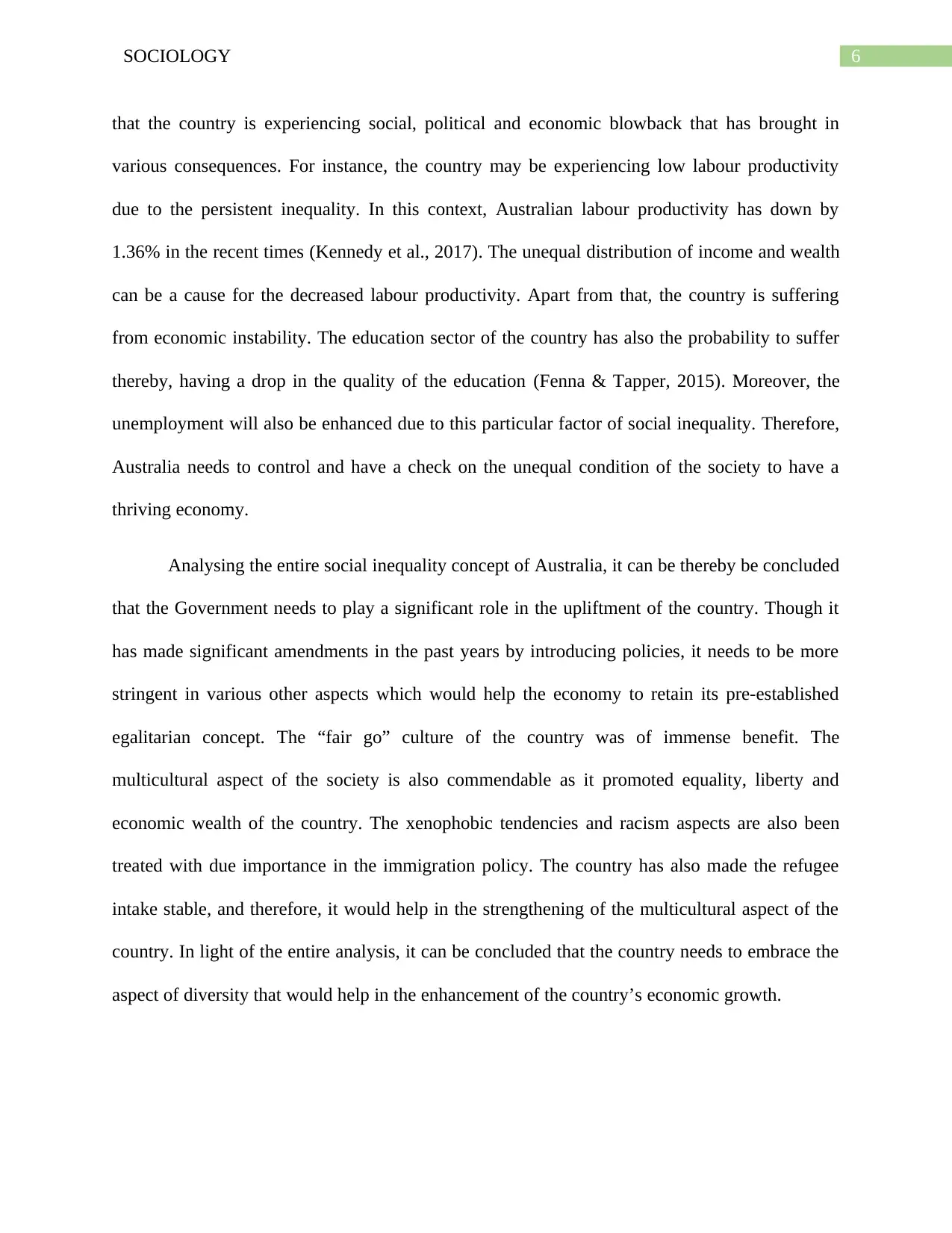
6SOCIOLOGY
that the country is experiencing social, political and economic blowback that has brought in
various consequences. For instance, the country may be experiencing low labour productivity
due to the persistent inequality. In this context, Australian labour productivity has down by
1.36% in the recent times (Kennedy et al., 2017). The unequal distribution of income and wealth
can be a cause for the decreased labour productivity. Apart from that, the country is suffering
from economic instability. The education sector of the country has also the probability to suffer
thereby, having a drop in the quality of the education (Fenna & Tapper, 2015). Moreover, the
unemployment will also be enhanced due to this particular factor of social inequality. Therefore,
Australia needs to control and have a check on the unequal condition of the society to have a
thriving economy.
Analysing the entire social inequality concept of Australia, it can be thereby be concluded
that the Government needs to play a significant role in the upliftment of the country. Though it
has made significant amendments in the past years by introducing policies, it needs to be more
stringent in various other aspects which would help the economy to retain its pre-established
egalitarian concept. The “fair go” culture of the country was of immense benefit. The
multicultural aspect of the society is also commendable as it promoted equality, liberty and
economic wealth of the country. The xenophobic tendencies and racism aspects are also been
treated with due importance in the immigration policy. The country has also made the refugee
intake stable, and therefore, it would help in the strengthening of the multicultural aspect of the
country. In light of the entire analysis, it can be concluded that the country needs to embrace the
aspect of diversity that would help in the enhancement of the country’s economic growth.
that the country is experiencing social, political and economic blowback that has brought in
various consequences. For instance, the country may be experiencing low labour productivity
due to the persistent inequality. In this context, Australian labour productivity has down by
1.36% in the recent times (Kennedy et al., 2017). The unequal distribution of income and wealth
can be a cause for the decreased labour productivity. Apart from that, the country is suffering
from economic instability. The education sector of the country has also the probability to suffer
thereby, having a drop in the quality of the education (Fenna & Tapper, 2015). Moreover, the
unemployment will also be enhanced due to this particular factor of social inequality. Therefore,
Australia needs to control and have a check on the unequal condition of the society to have a
thriving economy.
Analysing the entire social inequality concept of Australia, it can be thereby be concluded
that the Government needs to play a significant role in the upliftment of the country. Though it
has made significant amendments in the past years by introducing policies, it needs to be more
stringent in various other aspects which would help the economy to retain its pre-established
egalitarian concept. The “fair go” culture of the country was of immense benefit. The
multicultural aspect of the society is also commendable as it promoted equality, liberty and
economic wealth of the country. The xenophobic tendencies and racism aspects are also been
treated with due importance in the immigration policy. The country has also made the refugee
intake stable, and therefore, it would help in the strengthening of the multicultural aspect of the
country. In light of the entire analysis, it can be concluded that the country needs to embrace the
aspect of diversity that would help in the enhancement of the country’s economic growth.
Paraphrase This Document
Need a fresh take? Get an instant paraphrase of this document with our AI Paraphraser
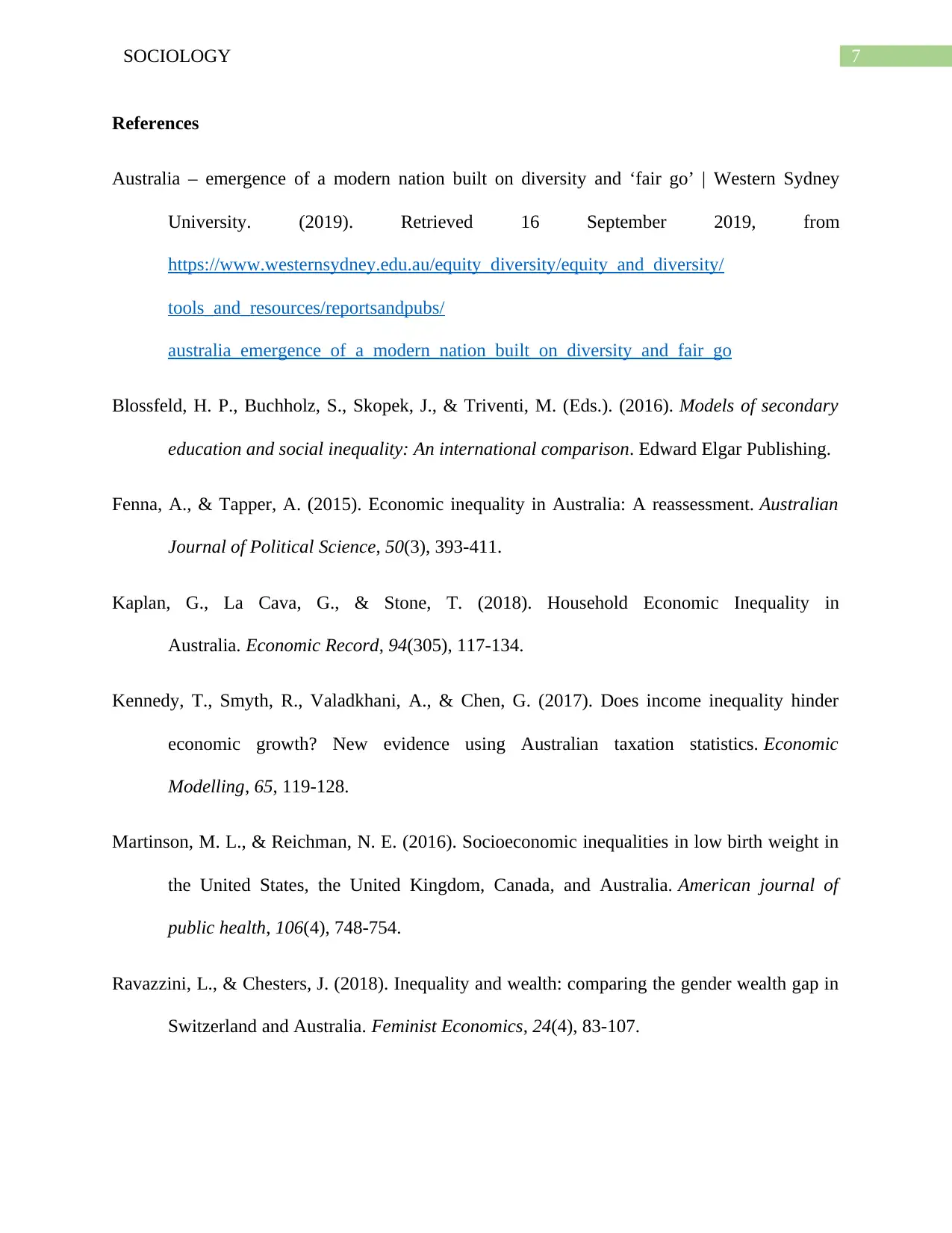
7SOCIOLOGY
References
Australia – emergence of a modern nation built on diversity and ‘fair go’ | Western Sydney
University. (2019). Retrieved 16 September 2019, from
https://www.westernsydney.edu.au/equity_diversity/equity_and_diversity/
tools_and_resources/reportsandpubs/
australia_emergence_of_a_modern_nation_built_on_diversity_and_fair_go
Blossfeld, H. P., Buchholz, S., Skopek, J., & Triventi, M. (Eds.). (2016). Models of secondary
education and social inequality: An international comparison. Edward Elgar Publishing.
Fenna, A., & Tapper, A. (2015). Economic inequality in Australia: A reassessment. Australian
Journal of Political Science, 50(3), 393-411.
Kaplan, G., La Cava, G., & Stone, T. (2018). Household Economic Inequality in
Australia. Economic Record, 94(305), 117-134.
Kennedy, T., Smyth, R., Valadkhani, A., & Chen, G. (2017). Does income inequality hinder
economic growth? New evidence using Australian taxation statistics. Economic
Modelling, 65, 119-128.
Martinson, M. L., & Reichman, N. E. (2016). Socioeconomic inequalities in low birth weight in
the United States, the United Kingdom, Canada, and Australia. American journal of
public health, 106(4), 748-754.
Ravazzini, L., & Chesters, J. (2018). Inequality and wealth: comparing the gender wealth gap in
Switzerland and Australia. Feminist Economics, 24(4), 83-107.
References
Australia – emergence of a modern nation built on diversity and ‘fair go’ | Western Sydney
University. (2019). Retrieved 16 September 2019, from
https://www.westernsydney.edu.au/equity_diversity/equity_and_diversity/
tools_and_resources/reportsandpubs/
australia_emergence_of_a_modern_nation_built_on_diversity_and_fair_go
Blossfeld, H. P., Buchholz, S., Skopek, J., & Triventi, M. (Eds.). (2016). Models of secondary
education and social inequality: An international comparison. Edward Elgar Publishing.
Fenna, A., & Tapper, A. (2015). Economic inequality in Australia: A reassessment. Australian
Journal of Political Science, 50(3), 393-411.
Kaplan, G., La Cava, G., & Stone, T. (2018). Household Economic Inequality in
Australia. Economic Record, 94(305), 117-134.
Kennedy, T., Smyth, R., Valadkhani, A., & Chen, G. (2017). Does income inequality hinder
economic growth? New evidence using Australian taxation statistics. Economic
Modelling, 65, 119-128.
Martinson, M. L., & Reichman, N. E. (2016). Socioeconomic inequalities in low birth weight in
the United States, the United Kingdom, Canada, and Australia. American journal of
public health, 106(4), 748-754.
Ravazzini, L., & Chesters, J. (2018). Inequality and wealth: comparing the gender wealth gap in
Switzerland and Australia. Feminist Economics, 24(4), 83-107.
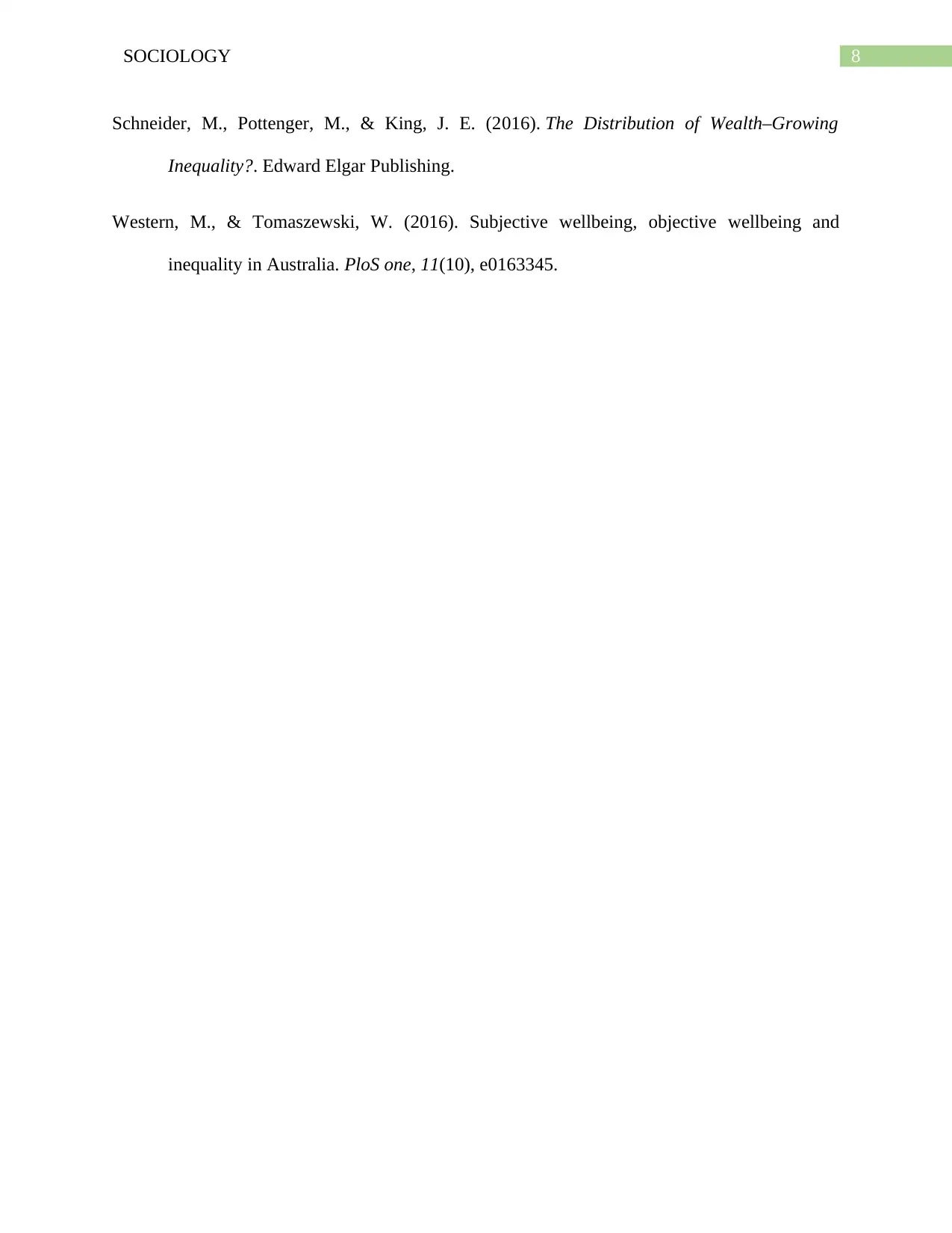
8SOCIOLOGY
Schneider, M., Pottenger, M., & King, J. E. (2016). The Distribution of Wealth–Growing
Inequality?. Edward Elgar Publishing.
Western, M., & Tomaszewski, W. (2016). Subjective wellbeing, objective wellbeing and
inequality in Australia. PloS one, 11(10), e0163345.
Schneider, M., Pottenger, M., & King, J. E. (2016). The Distribution of Wealth–Growing
Inequality?. Edward Elgar Publishing.
Western, M., & Tomaszewski, W. (2016). Subjective wellbeing, objective wellbeing and
inequality in Australia. PloS one, 11(10), e0163345.
⊘ This is a preview!⊘
Do you want full access?
Subscribe today to unlock all pages.

Trusted by 1+ million students worldwide
1 out of 9
Your All-in-One AI-Powered Toolkit for Academic Success.
+13062052269
info@desklib.com
Available 24*7 on WhatsApp / Email
![[object Object]](/_next/static/media/star-bottom.7253800d.svg)
Unlock your academic potential
Copyright © 2020–2025 A2Z Services. All Rights Reserved. Developed and managed by ZUCOL.